2023.08.04.85
Files > Volume 8 > Vol 8 no 4 2023
The Effect of Partial Replacement of Yellow Corn by Iraqi Rice Bran Treated with multi-enzymes on the Broiler Performance
Tariq S. Almrsomi*, Ali J. Hammod, Ammar H. Areaaer
1 Department of Animal Production, Faculty of Agriculture,
2 Department of Animal Production, Faculty of Agriculture,
*Correspondence: [email protected].
Available from: Available from. http://dx.doi.org/10.21931/RB/2023.08.04.85
Available from: Available from. http://dx.doi.org/10.21931/RB/2023.08.04.85
ABSTRACT
Until recently, the central objective of poultry feed formulation was to supply common feedstuff such as corn. Today, the search for sustainable alternatives to traditional feed elements is a primary goal to reduce feed costs. This study was carried out to explore the production performance of the Rice bran in the feeding of broiler Ross 308 chicken. One hundred eighty chicks were fed with Rice bran diets treated with multi-enzyme as a partial replacement (10%) of Yellow Corn. Chicks were distributed into four treatment groups as follows: (L0) control (45% yellow corn), L1, L2 and L3 (10% Rice bran and 35% yellow corn). Rice bran was treated with different amounts of multi-enzymes: 500, 750, and 1000mg of Labazyme\kg diet, respectively. The results showed a significant (P≤0.05) decrease in the marketing live body weight and total weight gain for broilers fed with 10% Rice bran and 35% yellow corn. The accumulative feed consumption and conversion ratio were unaffected (no significant difference at P≤0.05) when the Rice bran was treated with 1000 mg of Labazyme\kg diet. This present study concludes that a diet with 10% Rice bran and 35% yellow corn hurts the growth performance of broiler chicken. However, the breeding cost of broiler Ross 308 chicken was reduced when the Rice bran was treated with 1000 mg/kg multi-enzymes (L3 group). There were no effects on the mortality rate of all experimental groups.
Keyword: Broiler, Labazyme, Performance, Rice bran, Ross 308.
INTRODUCTION
The raw materials used in human feeding in poultry production systems should be reduced. Corn is the primary cereal used in poultry production systems. Thus, using alternative by-products, such as rice bran, according to their nutritional value and availability, will increase the ability of feed formulation and decrease the use of expensive feedstuff. Thus, yellow corn can be partially substituted by Rice bran as its nutritional features are similar to those of corn 1. The Rice bran contains more lysine (4.8%), cysteine (5.4%) and threonine (4.2%) than corn. It also contains higher levels of total crude protein, around 13%, and lipids, 13%, than corn 2. It has a low portion of starch in comparison with corn, which reduces the risk of infection by Mycotoxin 3 . Rice bran is a great nutrition compound as it is rich in oryzanols, tocopherols, tocotrienols, phytosterols, and vitamin E, which are micronutrients and antioxidant Consequently, the Rice bran may be used as a low-cost source of energy in chickens Diet. The partial replacement of yellow corn by 12.5, 25% raw Rice bran has reduced the broilers’ diet digestibility and growth rate. The high fiber content of raw rice bran causes this reduction. 4 Few studies have demonstrated that the enzymatic treatment of rice bran can digest the fibers and make the nutrients more accessible. The enzymatic treatment of Rice bran before using it in the feed of laying hens as a partial replacement for yellow corn has enhanced egg production and egg quality. 5,6 found that the partial replacement of yellow corn (up to 7.5%) by Raw Rice bran did not affect broilers’ meat quality and production performance. At the same time, the entire replacement of yellow corn with Rice bran reduced the production performance during the same feeding period 7. Feed intake was reduced when a higher percentage of Rice bran was used 8. Adding carbohydrase enzyme individually or in combination with Phytase to feed that contains raw Rice bran has increased the availability of nutrients and improved body weight gain 9. No research has been conducted to investigate the effect of Iraqi Rice bran treatment with variable levels of Labazyme as a multi-enzyme on broilers’ performance. This experiment aimed to assess the nutritional value of Iraqi rice bran after treatment with different amounts of multi-enzymes. This experiment is the first to investigate the improvement effect of ribozyme treatment on the nutritional value of Iraqi rice bran as an energy source in a broiler diet. It is also one of the few experiments that assess the usefulness of partial replacement of yellow corn by 10% of enzymatically treated Iraqi Rice bran on broiler performance.
MATERIALS AND METHODS
Diets and management
The experiment was conducted in Fowl Farm, Department of Animal Production, Faculty of Agriculture, University of Kufa, from February 1 to March 7, 2022, for 5 weeks. Rice bran was collected from Iraqi Anbar rice and treated with Labazyme in concentrations of 500, 750, and 1000 mg\ kg of diet. The Labazyme is a multi-enzyme manufactured by New Pharm (a Korean company) consisting of Protease (2.750 CSU), Amylase (5.500 SLU) and Cellulase (27.5 FPUi). The experiment was carried out by a completely randomized design (CRD). One hundred eighty broiler Ross 308 chicks at 1 day old, 42g initial weight was used, Provided by (Al-Anwar Hatchery- Babylon). The chicks were randomly distributed to 4 treatment groups (45 chicks\treatment) with 3 replicates (15 each) as follows:
L0 was a control (45% corn + 0% rice bran), and L1, L2 and L3 were added 500, 750, and 1000 mg of Labazyme per 1 kg diet, respectively. The yellow corn was partially replaced with 10% of differently treated Rice bran (35% corn + 10% Rice bran), as shown in Table 1. All chicks were fed diets which
The experiment was conducted in Fowl Farm, Department of Animal Production, Faculty of Agriculture, University of Kufa, from February 1 to March 7, 2022, for 5 weeks. Rice bran was collected from Iraqi Anbar rice and treated with Labazyme in concentrations of 500, 750, and 1000 mg\ kg of diet. The Labazyme is a multi-enzyme manufactured by New Pharm (a Korean company) consisting of Protease (2.750 CSU), Amylase (5.500 SLU) and Cellulase (27.5 FPUi). The experiment was carried out by a completely randomized design (CRD). One hundred eighty broiler Ross 308 chicks at 1 day old, 42g initial weight was used, Provided by (Al-Anwar Hatchery- Babylon). The chicks were randomly distributed to 4 treatment groups (45 chicks\treatment) with 3 replicates (15 each) as follows:
L0 was a control (45% corn + 0% rice bran), and L1, L2 and L3 were added 500, 750, and 1000 mg of Labazyme per 1 kg diet, respectively. The yellow corn was partially replaced with 10% of differently treated Rice bran (35% corn + 10% Rice bran), as shown in Table 1. All chicks were fed diets which
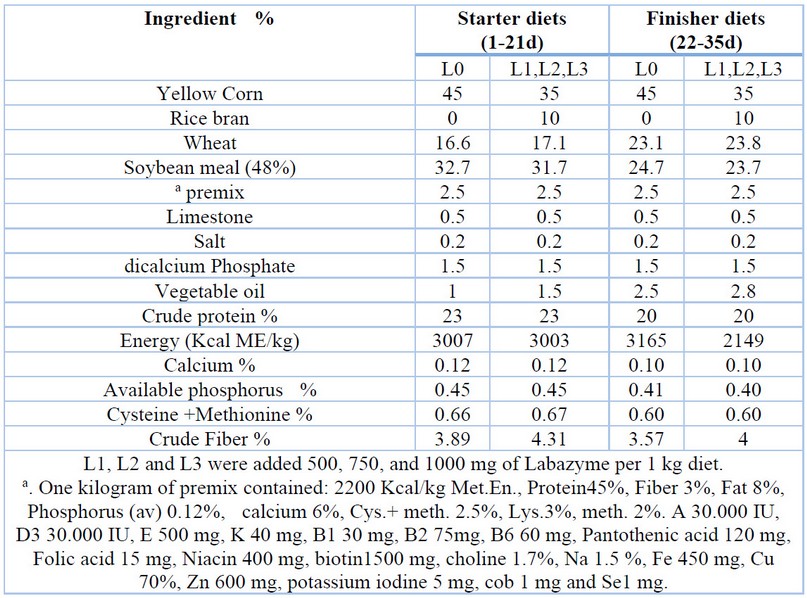
Table 1. The content of the experimental diets %.
L1, L2 and L3 were added 500, 750, and 1000 mg of Labazyme per 1 kg diet.
a. One kilogram of premix contained: 2200 Kcal/kg Met.En., Protein45%, Fiber 3%, Fat 8%, Phosphorus (av) 0.12%, calcium 6%, Cys.+ meth. 2.5%, Lys.3%, meth. 2%. A 30.000 IU, D3 30.000 IU, E 500 mg, K 40 mg, B1 30 mg, B2 75mg, B6 60 mg, Pantothenic acid 120 mg, Folic acid 15 mg, Niacin 400 mg, biotin1500 mg, choline 1.7%, Na 1.5 %, Fe 450 mg, Cu 70%, Zn 600 mg, potassium iodine 5 mg, cob 1 mg and Se1 mg.
Presented in mash form during the first three weeks of age (1 - 21 days) by starter diet (23% protein and 3000 Kcal ME\kg), while during (22 - 35 days) with finisher diet (20% crude protein and 3150 Kcal ME\kg) which formulated according to NRC (1994). The chicks were distributed to 15 Pens (200 × 150 cm per pen) in floor cages, which were provided with artificial lighting (23 hours\day) for 5 weeks of the experimental period. A mixture of minerals and vitamins was added to the feed to cover the nutritional requirements of chicken diets by the management guide of broiler Ross 308(2018). Broilers had ad libitum access to water and feed. Live body weights and feed consumption were recorded at 7, 14, 21, 28, and 35 days of age, while mortality was recorded daily. There was no chicken mortality during the experiments, but body weight gain and feed conversion ratio were calculated weekly.
a. One kilogram of premix contained: 2200 Kcal/kg Met.En., Protein45%, Fiber 3%, Fat 8%, Phosphorus (av) 0.12%, calcium 6%, Cys.+ meth. 2.5%, Lys.3%, meth. 2%. A 30.000 IU, D3 30.000 IU, E 500 mg, K 40 mg, B1 30 mg, B2 75mg, B6 60 mg, Pantothenic acid 120 mg, Folic acid 15 mg, Niacin 400 mg, biotin1500 mg, choline 1.7%, Na 1.5 %, Fe 450 mg, Cu 70%, Zn 600 mg, potassium iodine 5 mg, cob 1 mg and Se1 mg.
Presented in mash form during the first three weeks of age (1 - 21 days) by starter diet (23% protein and 3000 Kcal ME\kg), while during (22 - 35 days) with finisher diet (20% crude protein and 3150 Kcal ME\kg) which formulated according to NRC (1994). The chicks were distributed to 15 Pens (200 × 150 cm per pen) in floor cages, which were provided with artificial lighting (23 hours\day) for 5 weeks of the experimental period. A mixture of minerals and vitamins was added to the feed to cover the nutritional requirements of chicken diets by the management guide of broiler Ross 308(2018). Broilers had ad libitum access to water and feed. Live body weights and feed consumption were recorded at 7, 14, 21, 28, and 35 days of age, while mortality was recorded daily. There was no chicken mortality during the experiments, but body weight gain and feed conversion ratio were calculated weekly.
Statistical analysis
Data obtained from this study was tested for significance by one-way ANOVA using GLM procedures of 10. Duncan’s multiple collection test (1955) checked the differences between treatment means.
Data obtained from this study was tested for significance by one-way ANOVA using GLM procedures of 10. Duncan’s multiple collection test (1955) checked the differences between treatment means.
No significant differences in the live body weight (LBW) of chicks during the experimental period (shown in Table) during 7 days of age were found in comparison with the control group (L0). During 14 days of age, a significant (P≤0.05) increase in the body weight of the L0 and L3 groups was recorded, and groups L1 and L2 recorded the lowest body weight. Significant (P≤0.05) decreases in body weight were found between experimental treatments and control L0, which recorded the maximum LBW during 21, 28, and 35 days of age, while the L3 group was the second one, and L1, L2 was the lowest during the same periods. In the statistical analysis of the influence of partial replacement of 10% Rice bran (treated with Labazyme) for yellow corn on body weight gain (BWG), in Table (3), the results indicated that a significance (P≤0.05) decrease in body weight gain during the first week of age was found between experimental treatments and control, but during (15-21), (22- 28) and (29- 35) days of age, no difference was found between L0 and L3 while L2 and L3 have recorded a significant (P≤0.05) depression during the same periods, also during the total period 1-35 day of age.
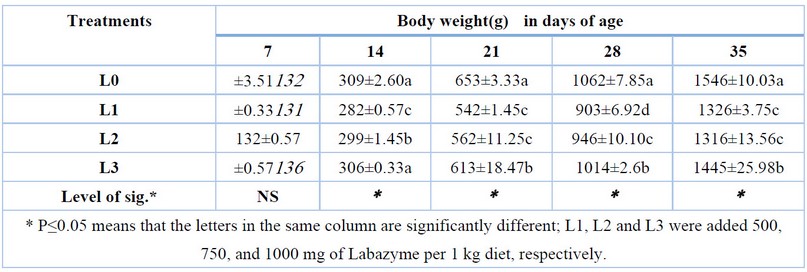
Table 2. The live body weight response of Broiler Ross 308 Fed 10 % of Rice Bran as a Partial replacement for the Yellow Corn was treated with Labazyme (Mean ± standard error).
Feed consumption has significantly (P≤0.05) decreased in all experimental groups in comparison with the control group L0 at (15-21), (22-28) and (29-35) days of age and also during the total period (1-35 days of age). L1 and L2 recorded the lowest feed consumption. At the same time, L0 (control) and L3 recorded a higher feed intake than L1 and L2.
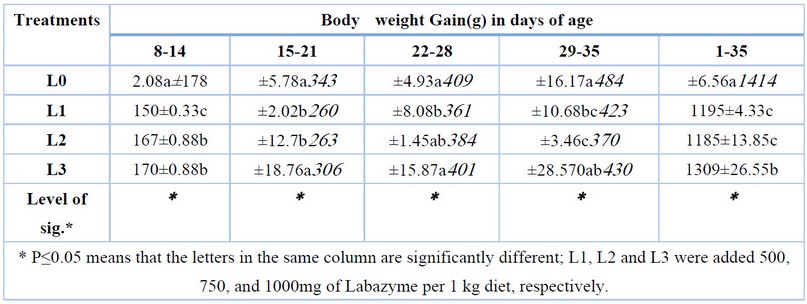
Table 3. Body weight Gain response of Broiler Ross 308 Fed 10 % of Rice Bran as a Partial replacement for the Yellow Corn and treated with Labazyme (Mean ± standard error).
Feed conversion ratio was significantly (P≤0.05) decreased for L1, L2 and L3 in comparison with the L0 control at (15-21) days of age. The feed conversion ratio of L0 and L3 during the total period (1-35 days of age) was significantly (P≤0.05) better in comparison with L1 and L2, which recorded 1.63 and 1.66, respectively.
All the experimental birds showed significant (P≤0.05) differences for all productive characters during the total period (1-35) days of age. There were no significant differences in LBW in all test groups and control at the first week of age, but the depression started and continued after the first week. However, the highest enzyme concentration used to treat Rice bran (L3) gave an LBW close to the control group. The body weight gain also decreased with lower enzyme concentration treatment, similar to LBW; the BWG of group L3 (treated with 1000mg/kg) was close to that of the control group. The enzymatic treatment needs further optimization using a higher enzyme concentration (more than 1000mg/kg) to perform better. Higher enzyme concentrations will digest all the fibrous contents of rice bran, including all nutrients, and make them available for birds. On the other hand, there was no significant (P≤0.05) difference in the feed conversion ratio between the control group and L3, which means that the production cost can be reduced using enzymatically treated Rice bran.
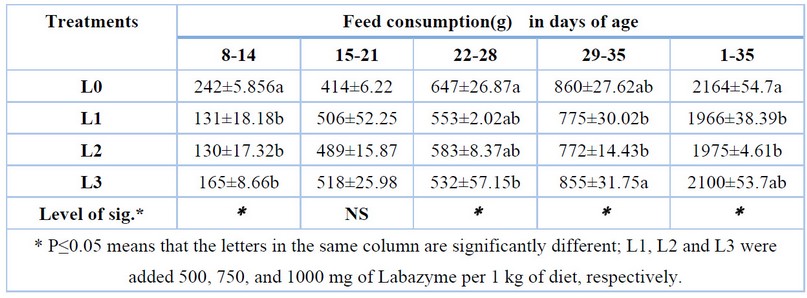
Table 4. Feed consumption (g/bird/week) response of Broiler Ross 308 Fed 10 % of Rice Bran as a Partial replacement for the Yellow Corn and treated with Labazyme (Mean ± standard error).
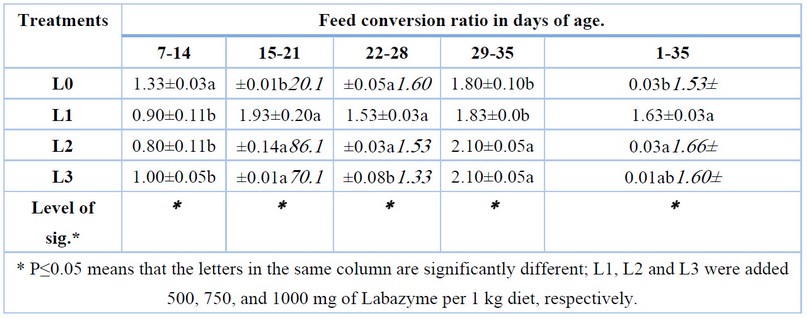
Table 5. Feed conversion ratio response of Broiler Ross 308 Fed 10% of Rice Bran as a Partial replacement for the Yellow Corn and treated with Labazyme (Mean ± standard error).
The growth rate was significantly dropped in the test groups (L1 and L2) due to the presence of high fiber content due to low enzyme concentration treatment (500 and 750mg/kg). Fibers can trap the nutrients and reduce performance because of the bulkiness effect. This agrees with the finding of 4,11,12, who showed that non-starch polysaccharides (NSP) present in the diet lead to low broiler growth performance, `and the use of enzymes improves the nutritional value of rice bran. The negative effect of fiber is more significant on body weight and feed conversion ratio when rice bran is used in broiler diets 8. Using Rice bran in the finisher diet has also reduced the broiler performance 13. In general comparison, the improved performance of broiler chicken growth represented by feed conversion ratio confirms that using enzymes reduces the fiber content in a treated diet and proposes the rice bran as a candidate replacement for yellow corn in feed formulation.
The Iraqi Rice bran treated with a high concentration of multi-enzymes is helpful as a readily available and inexpensive dietary component for feed formulation. Optimizing the enzyme concentration for Rice bran treatment (higher than 1000mg/Kg) will enhance broiler growth performance. The Iraqi Rice bran is safe to be used as a feedstuff as it has no adverse effects on the mortality rate. Further research is required to determine the optimum amount of Labazyme to treat Iraqi Rice bran and the impact of this optimum concentration on broiler health and growth performance.
1. Alyaseen, A.A. and Abdul abass, M.H. Poultry feeding. first edition, College of Agriculture - University of Baghdad, Baghdad, Iraq.
2. Steel, RC and Torrie, J.H.1980. Principle and procedures of Statistics. 2nd edition. New York, United States of America: McGraw-Hill Book Co. 2010.
3. Mohammadigheisar, T., Shouldice, V. L., Torrey, S., Widowski, Tina M., Ward, Nelson E., and Kiarie Elijah G. Growth performance, organ attributes, nutrient and caloric utilization in broiler chickens differing in growth rates when fed a corn-soybean meal diet with multi enzyme supplement containing phytase, protease and fiber degrading enzymes. Poultry Science,100,1-11. https://doi.org/10.1016/j.psj.2021.101362. 2021.
4. Alshukri, A.Y., Almrsomi, T. S., Areaaer, A. H. and Alfartosi, K. A. Effect of Partial Substitution of Rice bran for the Yellow Corn (Maize) on Broiler Performance. International Science Research, 2016; 5, 2003-2006. https://www.researchgate.net/publication/312595327
5. S. F. Al-jughaify, A., Sh. J. Alobaidy, B. Effect Of Osmo-Hardening Seed On K And Na Concentration And Some Growth Properties Of Wheat Under Salt Stress. Anbar Journal Of Agricultural Sciences, 2023; 21(1): 32-43. doi: 10.32649/ajas.2023.179713 .
6. Al-Tayyar,I.S.and Almrsomi,T.S. The Growth Parameters Response of Broiler Chicks Fed Partial replacement of Rice Bran for the Yellow Corn. Al-Qadisiyah Journal For Agriculture Science, 2022;12, 93-97.
7. Alkhateeb, A. R. .; Ibrahim, W. .; Taha, A. A. . Correlation Between Udder Conformation With Daily Milk Yield Of Buffaloes. JLSAR 2021, 2, 61–65.
8. Priabudiman, Y. and Sukaryana, Y. The influence of Palm Kernel Cake and Rice Bran Fermentation product mixture to the Broiler Carcass Quality. International Journal Science and Engineering, 2012;2,1-3. Doi: 10.12777/ijse.2.1.1-3.
9. Sanchez, J., Thanabalan, A., Khanal, T., Patterson, R., Slominski, B. and Kiarie. E. Growth performance, gastrointestinal weight, microbial metabolites and apparent retention of components in broiler chickens fed up to 11% Rice bran in a corn-soybean meal diet without or with a multi-enzyme supplement. Animal Nutrition, 2019;5, 41-48. Doi: 10.1016/j.aninu.2018.12.001
10. Khudai M Y, Abdulateef S M, Mouhammed T Th, Alamili H S. Use of modern geometric design of fish ponds to increase welfare and blood parameters. Revis Bionatura 2023;8 (2) 82. http://dx.doi.org/10.21931/RB/2023.08.02.82 .
11. SAS. SAS/Statistics Users Guide: Statistics Cary. North Carolina, United States of America: SAS Institute Inc. 2012.
12. Sharma, R., Srivastava, T. and Saxena, D.C. Studies on Rice bran and its benefits- A Review. International Journal Engineering Research Application, 2015;5,107-112. http://www.ijera.com/papers/Vol5_issue5/Part%20-%202/Q50502107112.pdf
13. Chen, X., Yang, H. and Wang, Z. The Effect of Different Dietary Levels of Defatted Rice bran on . 2019.
14. Fan, L., Huang, R., Wu, C., Cao, Y., Du, T., Pu, G., Wang, H., Zhou, W., Li, P., Kim, S. W. Defatted Rice bran Supplementation in Diets of Finishing Pigs: Effects on Physiological, Intestinal Barrier, and Oxidative Stress Parameters. Animal Journal, 2020;499,1-12.Doi: 10.3390/ani10030449
Received: 26 September 2023 / Accepted: 15 April 2023 / Published: 15 December 2023
Citation: Almrsomi, T.S..; Hammod, A.J..; Areaaer, A.H. The Effect of Partial Replacement of yellow corn by Iraqi Rice Bran Treated with multi-enzymes on the Broiler performance. Revis Bionatura 2023;8 (4) 85. http://dx.doi.org/10.21931/RB/2023.08.04.85
Publisher’s Note: Bionatura stays neutral with regard to jurisdictional claims in published maps and institutional affiliations.
